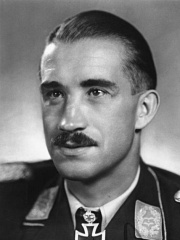
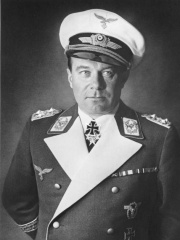
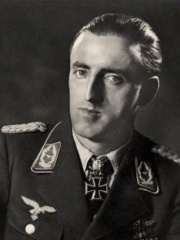

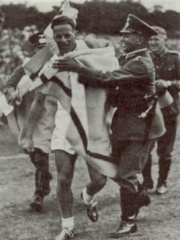
The Most Famous
PILOTS from Germany
This page contains a list of the greatest German Pilots. The pantheon dataset contains 71 Pilots, 6 of which were born in Germany. This makes Germany the birth place of the 4th most number of Pilots behind United States, and France.
Top 6
The following people are considered by Pantheon to be the most legendary German Pilots of all time. This list of famous German Pilots is sorted by HPI (Historical Popularity Index), a metric that aggregates information on a biography's online popularity.

1. Adolf Galland (1912 - 1996)
With an HPI of 71.11, Adolf Galland is the most famous German Pilot. His biography has been translated into 36 different languages on wikipedia.
Adolf Josef Ferdinand Galland (19 March 1912 – 9 February 1996) was a German Luftwaffe general and flying ace who served throughout the Second World War in Europe. He flew 705 combat missions and fought on the Western Front and in the Defence of the Reich. On four occasions, he survived being shot down, and he was credited with 104 aerial victories, all of them against the Western Allies. Galland, who was born in Westerholt, Recklinghausen, Province of Westphalia, Kingdom of Prussia, in the German Empire, became a glider pilot in 1929 before he joined the Luft Hansa. In 1932, he graduated as a pilot at the Deutsche Verkehrsfliegerschule (German Commercial Flyers' School) in Braunschweig before applying to join the Reichswehr of the Weimar Republic later in the year. Galland's application was accepted, but he never took up the offer. In February 1934, he was transferred to the Luftwaffe. In 1937, during the Spanish Civil War, he volunteered for the Condor Legion and flew ground attack missions in support of the Nationalists under Francisco Franco. After finishing his tour in 1938 Galland was employed in the Air Ministry writing doctrinal and technical manuals about his experiences as a ground-attack pilot. During this period Galland served as an instructor for ground-attack units. During the German invasion of Poland in September 1939, he again flew ground attack missions. In early 1940, Galland managed to persuade his superiors to allow him to become a fighter pilot. Galland flew Messerschmitt Bf 109s during the Battle of France and the Battle of Britain. By the end of 1940, his tally of victories had reached 57. In 1941, Galland stayed in France and fought the Royal Air Force (RAF) over the English Channel and Northern France. By November 1941, his tally had increased to 96, by which time he had earned the Knight's Cross of the Iron Cross with Oak Leaves and Swords. In November 1941, Werner Mölders, who commanded the German Fighter Force as the General der Jagdflieger, was killed while a passenger in a flying accident and Galland succeeded him, staying in the position until January 1945. As General der Jagdflieger, Galland was forbidden to fly combat missions. In late January and early February 1942, Galland first planned and then commanded the Luftwaffe's air cover for the Kriegsmarine Operation Cerberus, which was a major success. It earned him the Knight's Cross of the Iron Cross with Oak Leaves, Swords and Diamonds. Over the ensuing years, Galland's disagreements with Reichsmarschall Hermann Göring about how best to combat the Allied Air Forces bombing of Germany caused their relationship to deteriorate. The Luftwaffe fighter force was under severe pressure by 1944, and Galland was blamed by Göring for the failure to prevent the Allied strategic bombing of Germany in daylight. The relationship collapsed altogether in early January 1945, when Galland was relieved of his command because of his constant criticism of the Luftwaffe leadership. Galland was then put under house arrest following the so-called Fighter Pilots' Revolt, in which senior fighter pilots confronted Göring about the conduct of the air war. In March 1945, Galland returned to operational flying and was permitted to form a jet fighter unit which he called Jagdverband 44. He flew missions over Germany until the end of the war in May. After the war, Galland was employed by Argentina's Government and acted as a consultant to the Argentine Air Force. Later, he returned to Germany and managed his own business. Galland also became friends with many former enemies, such as RAF aces Robert Stanford Tuck and Douglas Bader.

2. Ernst Udet (1896 - 1941)
With an HPI of 70.41, Ernst Udet is the 2nd most famous German Pilot. His biography has been translated into 36 different languages.
Ernst Udet (26 April 1896 – 17 November 1941) was a German pilot during World War I and a Luftwaffe Colonel-General (Generaloberst) during World War II. Udet joined the Imperial German Air Service in April 1915 at the age of 19, and eventually became a notable flying ace of World War I, scoring 62 confirmed victories. The highest scoring German fighter pilot to survive that war, and the second-highest scoring after Manfred von Richthofen, his commander in the Flying Circus, Udet rose to become a squadron commander under Richthofen, and later under Hermann Göring. Udet spent the 1920s and early 1930s as a stunt pilot, international barnstormer, light-aircraft manufacturer, and playboy. On 1 May 1933 Udet joined the Nazi Party. He became involved in the early development of the Luftwaffe (officially founded on 15 May 1933), where he was appointed director of research and development. Influential in the adoption of dive-bombing techniques as well as of the Stuka dive bomber, by 1939 Udet had risen to the post of Chief of Procurement and Supply for the Luftwaffe. The stress of the position and his distaste for administrative duties led to Udet developing alcoholism. The launch of Operation Barbarossa on 22 June 1941, combined with issues with the Luftwaffe's needs for equipment outstripping Germany's production capacity and increasingly poor relations with the Nazi Party, caused Udet to choose suicide on 17 November 1941 by shooting himself in the head.

3. Hermann Graf (1912 - 1988)
With an HPI of 66.19, Hermann Graf is the 3rd most famous German Pilot. His biography has been translated into 25 different languages.
Hermann Graf (24 October 1912 – 4 November 1988) was a German Luftwaffe World War II fighter ace. He served on both the Eastern and Western Fronts. He became the first pilot in aviation history to claim 200 aerial victories—that is, 200 aerial combat encounters resulting in the destruction of the enemy aircraft. In about 830 combat missions, he claimed a total of 212 aerial victories, almost all of which were achieved on the Eastern Front. Graf, a pre-war football player and glider pilot, joined the Luftwaffe and started flight training in 1936. He was initially selected for transport aviation but was subsequently posted to Jagdgeschwader 51 (JG 51—51st Fighter Wing) in May 1939. At the outbreak of war he was stationed on the Franco–German border flying uneventful patrols. He was then posted as a flight instructor stationed in Romania as part of a German military mission training Romanian pilots. Graf flew a few ground support missions in the closing days of the German invasion of Crete. Following the start of Operation Barbarossa, the German invasion of the Soviet Union, Graf claimed his first aerial victory on 4 August 1941. He was awarded the Knight's Cross of the Iron Cross after 45 victories on 24 January 1942. It was during the second summer of the eastern campaign; however, that his success rate dramatically increased. By 16 September 1942 his number of victories had increased to 172 for which he was honored with the Knight's Cross of the Iron Cross with Oak Leaves, Swords and Diamonds. At the time of its presentation to Graf it was Germany's highest military decoration. On 26 September 1942 he shot down his 200th enemy aircraft. By then a national hero, Graf was withdrawn from combat operations and posted to a fighter pilot training school in France before being tasked with the setting up of a new special unit: Jagdgeschwader 50 (JG 50—Fighter Wing 50). Its mission was as a high-altitude unit to intercept the de Havilland Mosquito intruders. In November 1943 Graf returned to combat operations. He was appointed Geschwaderkommodore (Wing Commander) of Jagdgeschwader 11 (JG 11—11th Fighter Wing) and claimed his last and 212th aerial victory on 29 March 1944. He was severely injured during that encounter and, after a period of convalescence, became Geschwaderkommodore of Jagdgeschwader 52 (JG 52—52nd Fighter Wing). He and the remainder of JG 52 surrendered to units of the United States Army on 8 May 1945, but were turned over to the Red Army. Graf was held in Soviet captivity until 1949. After the war he worked as an electronic sales manager and died after a long illness in his home town of Engen on 4 November 1988.

4. Mathias Rust (b. 1968)
With an HPI of 63.34, Mathias Rust is the 4th most famous German Pilot. His biography has been translated into 44 different languages.
Mathias Rust (born 1 June 1968) is a German aviator. In 1987, as a teenage amateur pilot, he flew from Helsinki, Finland, to Moscow, without authorization. According to Russian claims, he was tracked several times by Soviet Air Defence Forces and civilian air traffic controllers, as well as Soviet Air Force interceptor aircraft. The Soviet fighters did not receive permission to shoot him down, and his aeroplane was mistaken for a friendly aircraft several times. Also, 28 May 1987 was Border Guards Day, leaving many guards distracted. He landed on Bolshoy Moskvoretsky Bridge, next to Red Square near the Kremlin in the capital of the USSR. Rust said he wanted to create an "imaginary bridge" to the East, and that his flight was intended to reduce tension and suspicion between the two Cold War sides. Rust was sentenced to four years in a general-regime labour camp for violation of border crossing and air traffic regulations, and for provoking an emergency situation upon his landing. After 14 months in prison, he was pardoned by Andrei Gromyko, the Chairman of the Presidium of the Supreme Soviet, and released. Rust's flight through a supposedly impenetrable air defence system had a great effect on the Soviet military and resulted in the dismissal of many senior officers, including Minister of Defence Marshal of the USSR Sergei Sokolov and the Commander-in-Chief of the Soviet Air Defence Forces, former World War II fighter pilot ace Chief Marshal Alexander Koldunov. The incident aided Mikhail Gorbachev in the implementation of his reforms, by allowing him to dismiss numerous military officials opposed to his policies.
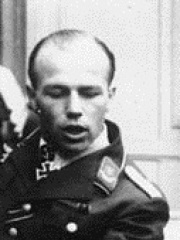
5. Helmut Wick (1915 - 1940)
With an HPI of 57.44, Helmut Wick is the 5th most famous German Pilot. His biography has been translated into 15 different languages.
Helmut Paul Emil Wick (5 August 1915 – 28 November 1940) was a German flying ace of World War II. He was a wing commander in the Luftwaffe (air force) of Nazi Germany, and the fourth recipient of the Knight's Cross of the Iron Cross with Oak Leaves, the nation's highest military decoration at the time. Born in Mannheim, Wick joined the Luftwaffe in 1936 and was trained as a fighter pilot. He was assigned to Jagdgeschwader 2 "Richthofen" (JG 2—2nd Fighter Wing), and saw combat in the Battles of France and Britain. In October 1940, he was given the position of wing commander of JG 2—the youngest in the Luftwaffe to hold this position. Wick was shot down in the vicinity of the Isle of Wight on 28 November 1940, most likely by the British ace John Dundas, who was himself shot down by Wick's wingman. Wick was posted as missing in action, presumed dead. By then he had been credited with the destruction of 56 enemy aircraft in aerial combat, making him the leading German ace at the time. Flying the Messerschmitt Bf 109, he claimed all of his victories against the Western Allies.

6. Gotthard Handrick (1908 - 1978)
With an HPI of 57.18, Gotthard Handrick is the 6th most famous German Pilot. His biography has been translated into 21 different languages.
Gotthard Handrick (25 October 1908 – 30 May 1978) was a German Olympic athlete and German fighter pilot during the Spanish Civil War and World War II.
People
Pantheon has 6 people classified as German pilots born between 1896 and 1968. Of these 6, 1 (16.67%) of them are still alive today. The most famous living German pilots include Mathias Rust. The most famous deceased German pilots include Adolf Galland, Ernst Udet, and Hermann Graf.
Living German Pilots
Go to all RankingsDeceased German Pilots
Go to all RankingsAdolf Galland
1912 - 1996
HPI: 71.11
Ernst Udet
1896 - 1941
HPI: 70.41
Hermann Graf
1912 - 1988
HPI: 66.19
Helmut Wick
1915 - 1940
HPI: 57.44
Gotthard Handrick
1908 - 1978
HPI: 57.18
Overlapping Lives
Which Pilots were alive at the same time? This visualization shows the lifespans of the 4 most globally memorable Pilots since 1700.

